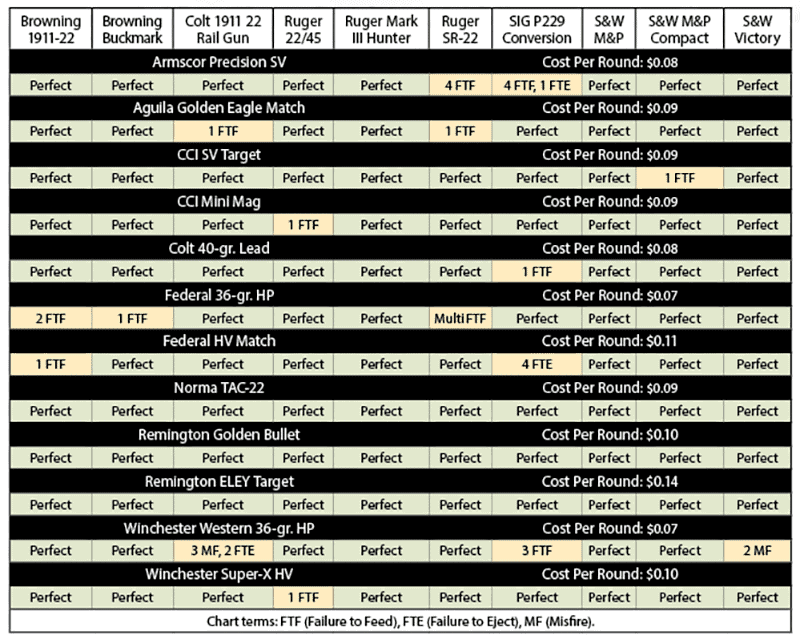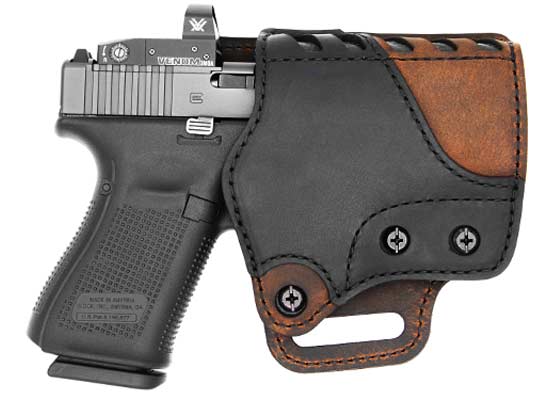Shootin' For The Cycle
The problem? .22 semi-autos can be finicky in terms of reliability.
Here’s one handgun instructor’s method of
finding out what gun likes what ammo
A few years ago, I bought a SIG Mosquito .22 pistol, thinking it would be an inexpensive practice understudy for my 9mm SIG P226. The Mosquito handled some .22 LR loads well, but was very finicky when it came to others. This is typical of some semi-auto designs and it led me to want to dig deeper into the question of “just how finicky are.22 autos?”
In our NRA Basic Pistol classes, we supply the handguns and ammunition for our students. Our goal is to provide new shooters with a “non-recoil” experience while learning the basics. To make the class more interesting, we set it up so each shooter has the opportunity to shoot both a single- action and a double-action revolver and at least three different types of semi autos. To accomplish this goal, I have accumulated a variety of rimfire handguns, but finding ammo that will reliably cycle in all of the semi-autos has been a sketchy proposition.
Mix And Match
I confess I’ve been an ammo hoarder since the first shortage a few years ago and .22 ammo was high on my target list. I have guns, I have a bunch of ammo, but to make sure I consistently match the right ammo with the available guns, I needed to do some testing.
This was a mission I knew would require some planning. It wasn’t feasible for me to do all the shooting myself; it would take forever based on my schedule. If I were to gather a few friends at the range with the guns and ammo, the shooting would get done, but I doubted I would get any data. Without a plan, I would end up with a lot of empty brass, 10 dirty guns and no data.
It wasn’t hard to get volunteers to help me shoot the guns. In addition to a son and grandson, my volunteers included a young female instructor (who agreed to set it up for an early morning shoot before the regular crowd came in), plus the four instructors who work with me teaching Basic Pistol Courses and the Texas License to Carry Course. One is a 21-year Marine veteran, one is a fresh-out-of-college youngster who puts us all to shame with his knowledge of guns and the other is a guy somewhat senior, who — like me —became a student of the gun late in life.
Before range day, I went through my safe and sorted through all of my .22 semi-autos. From the ammo closet, I pulled out my ammo hoard and sorted through it to see what was on hand that would enable us to shoot at least two full magazines in each gun.
After sorting the ammo, I came up with 10 types of which I had at least 200 rounds. Selected for the exercise were: Armscor Precision Standard Velocity, Aguila Golden Eagle Match, CCI Standard Velocity Target, CCI Mini Mag, Colt 40-gr. Lead, Federal 36-gr. HP, Federal HV Match, Norma Tac-22, Remington Golden Bullet, Remington ELEY Target, Winchester-Western 36-gr. HP and Winchester Super-X HV.
Before going to the range, I cleaned all the guns and put together a basic cleaning kit to take along to make sure dirty feed ramps and dry slide rails wouldn’t affect the outcome.
To organize the shoot, I made a chart for each gun, listing each ammo type with columns to indicate whether or not the ammo cycled in the gun and a space for notes. Most ammo comparisons cover accuracy and muzzle velocity, but my primary concern was determining what ammo would cycle reliably in most — if not all — of my guns. And that is all I asked of my shooters.
When guys are having fun, however, trying a variety of guns and targets, it’s sometimes hard to keep them on track with the primary mission. The charts were designed to do that. I reached way back into my past for a tool for this mission — clipboards.
The Shoot-Off
We did the shooting at American Sportsman Shooting Center, just north of the Dallas-Fort Worth Airport. It’s a live-fire cinema shooting range with a BKE Hitcom computerized system. This projects targets on a white backdrop and records where the rounds hit using a combination of sound triangulation and cameras. With larger calibers, you actually see bullet holes, but with the .22’s, the holes were too small to see, so the computer projects a small plus sign everywhere a bullet impacts.
Since one of our shooters was an instructor there, she set up the targets presenting a variety of challenges. There were deer, foxes, hogs, coyotes and I don’t know what else, but all the shooters enjoyed themselves. Sometimes they shot slowly for accuracy, but several times I heard someone empty a 10-round mag in 2 or 3 seconds.
Although I knew my mission parameters, I wasn’t sure how to ensure only 20 rounds of each ammo type were shot in each of the 10 guns. One of the instructors suggested we give each shooter a specific brand and let them rotate the guns. As it turned out, it was the perfect way to run the exercise. The ammo and shooter stayed at each station and the guns were rotated clockwise as each shooter finished his/her 20 rounds.
The results were actually surprising. We had far fewer failures than I expected.
Ammo Winners — Three ammo types cycled perfectly in all the guns: Norma Tac-22, Remington Golden Bullet and Remington ELEY Target.
Runners Up — You can’t always get your first choice, so it’s a good idea to have something you can fall back on. Three ammo types had only one failure each: CCI Standard Velocity Target, Colt 40-gr. and Winchester Super X HV. I was surprised to find CCI Standard Velocity Target — with one failure to feed — had fewer problems than CCI Mini Mag, which had FTF issues in two guns. CCI Mini-Mag is usually considered the “go to” ammo for semi-auto consistency. Only the S&W M&P Compact had trouble with the CCI SV and it’s the only ammo it rejected with its one FTF.
Losers — Four types of ammo were ruled out for our specific training pistols: Federal 36-gr. HP, Federal HV Match, Armscor Precision and Winchester-Western. The Federal 36-gr. HP stuff is sold in both blue packages and maroon packages, but the specs are the same. It appears the maroon box is packaged for WalMart and the other for general distribution. The Winchester-Western is almost exclusively sold in bulk packs.
The Guns Themselves
There were only two perfect guns across the board — the full-size S&W M&P and the Ruger Mark III Hunter. The M&P, incidentally, was equipped with a suppressor, which should put to rest any questions about suppressors affecting reliability. Following close behind the M&P was its baby brother, the M&P Compact, with only one FTF. The Browning Buckmark was the only other gun to have just one failure.
Both Brownings did well with everything but the Federal ammo. The SIG P229 — which had the most issues — performed about like its baby brother, the Mosquito. If you shoot Norma Tac-22, Remington Golden Bullet or Remington ELEY Target, the P229 is fine, but it didn’t like a lot of the other stuff. The little Ruger SR-22 followed up with the second highest number of failures. It’s a fun gun to shoot, but it’s best to feed it one of the clear ammo winners.
The Colt 1911 and the Ruger SR-22 didn’t like Aguila Golden Eagle Match or the bulk-pack Winchester Western rounds, but handled the others okay. The SR-22 also choked on the Federal 36-gr. HP’s.
I put the results together in a color-coded chart for a visual overview (see pg 42). Most of the problems were feeding or extracting issues, but there were some misfires that could have been either light strikes or bad primers.
Cost, Labeling, Packaging
I did my best to find a meaningful cost-per-round for each of the ammo types. Some are available in bulk-packs, which reduce the cost slightly, but none of what we shot are really expensive compared to centerfire .380 ACP, 9mm or higher calibers. The cost on any of them wasn’t such that it would’ve affected my buying decision.
Labeling of .22 ammunition appears to be more of a marketing strategy than one of engineering consistency. I can’t find the Colt ammo anywhere. Upon some investigation, I discovered it appears to have been manufactured by Aguila in Mexico. Although the ELEY is branded as Remington, it’s actually manufactured in Great Britain. ELEY sells their own brand in the United States and I’m sure one of their loads is exactly the same as the Remington ELEY-branded cartridges.
Remington lists 11 different types of .22 LR ammo on their website, three of which are manufactured by ELEY. I’ve found Golden Bullet to always be reliable when sold in small packs. I’ve bought them in 1,400-round buckets and the quality control didn’t appear to be the same. Perhaps bouncing around in a bucket full of brass and lead makes a little bitty cartridge subject to some mishandling.
Just for fun I told my wife with my silenced S&W M&P I could take care of the rat and squirrel population somehow continuing to get into our garage and attic and not disturb the neighbors.
And I now know the three types of ammo most reliable for the job.
Editor’s Note:
Rimfire semi-autos are ammo-sensitive. What works consistently with one load may not work well with another. We’ve found all mainstream examples of .22 LR ammo to be reliable and accurate overall. You may have to experiment to find the right match!











